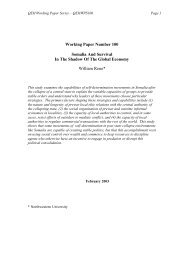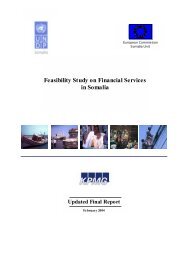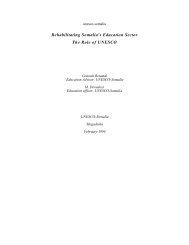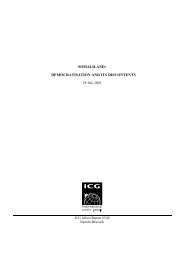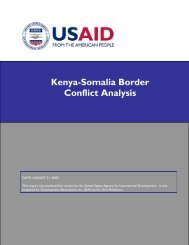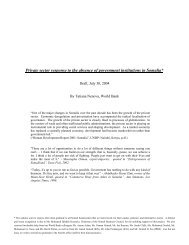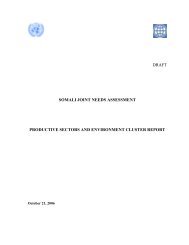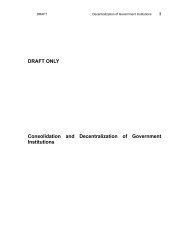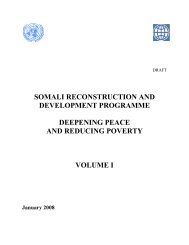Primary Education Survey Evaluation Report Somalia - Somali - JNA
Primary Education Survey Evaluation Report Somalia - Somali - JNA
Primary Education Survey Evaluation Report Somalia - Somali - JNA
Create successful ePaper yourself
Turn your PDF publications into a flip-book with our unique Google optimized e-Paper software.
PES <strong>Evaluation</strong> <strong>Report</strong>, 2008<br />
• A school report that should be provided within 3 months of data collection. This report can also<br />
be used as a data validation check. In addition it can be used by schools and CECs for planning<br />
processes and development of school improvement plans.<br />
• District reports that reflect education conditions within the district generally and allow schools<br />
and CECs to benchmark themselves and district officers to determine priorities<br />
• Regional reports that reflect education conditions across regions and allow for comparison of<br />
progress between regions.<br />
• Zone and <strong><strong>Somali</strong>a</strong> reports that that provide a summary of major EFA indicators and trends<br />
disaggregated by Region, gender and Rural/Urban. The tables in the current report would be<br />
available by front end module to data base.<br />
• A set of thematic reports that would change from year to year and would provide deeper analysis<br />
of EMIS data of issues of specific relevance. This might include gender, vulnerable and<br />
marginalised children, water and sanitation, condition of building or impact of specific<br />
programmes. It is expected that specialist technical assistance would be required to support this<br />
work. This technical assistance would be supported by a variety of interested agencies.<br />
• The capacity to interrogate the data base using the query module of Access would be developed<br />
at Zone level and would be available for generating specialised reports for stakeholders<br />
In preparing these reports specific attention should be paid to the technical capacity of the target group to<br />
interpret and use the reports. It has been suggested that a glossary of terms be included in each report to<br />
enhance readability.<br />
To make more explicit the thoughts behind the need for alternative reporting formats, a set of indicative<br />
data needs and how they might be used have been developed and included as Appendix7. They address a<br />
range of specific school, district and regional issues that are common issues in emerging education<br />
systems. They provide some direction as to how evidence based planning might begin.<br />
An emerging form of reporting is in the form of Maps. The EU has funded the Food and Agriculture<br />
Organisation to develop a <strong><strong>Somali</strong>a</strong> Dynamic Atlas. Data from the EMIS should systematically be<br />
integrated into a comparable atlas via GIS software. This format provides a useful form of collating data<br />
sets and providing easily accessed information in map form with associated attachments and tables. The<br />
GPS coordinates that have been collected in the PES will facilitate this synthesis. Such a synthesis is<br />
discussed further in the coordination section of this report.<br />
DEVINFO format of reporting should also be considered. DEVINFO is a data base format commonly<br />
used in developing countries for providing access to key data and indicators across a wide range of areas,<br />
including education, health, population, WASH, etc. It is not country specific and hence the data of many<br />
countries can be accessed using this format.<br />
It has become evident that there is little capacity in some zones in the areas of evidence based planning,<br />
monitoring of progress at various levels of the system, or school improvement planning. It will not be<br />
adequate to merely produce reports. It will therefore be necessary for support and training to be provided<br />
for many levels of the MoE, on how to use the reports to improve the education outcomes for the children<br />
of <strong><strong>Somali</strong>a</strong>.<br />
There already exists Community <strong>Education</strong> Committees (CEC) that provide support for education at the<br />
local level. Additionally, UNICEF is supporting a Community Development Project that aims to<br />
empower local communities to harness resources through identifying local needs and priorities, and<br />
proposal writing. These structures can be used to enhance education ownership at the local level. By<br />
linking to Community Development Committees (CDCs) this process can be used to mobilise resources.<br />
This process could be strengthened in the field of education by providing school/community reports that<br />
focus on reporting local conditions and facilities together with relevant comparisons. Such reports could<br />
be used to underpin local proposal development<br />
34



